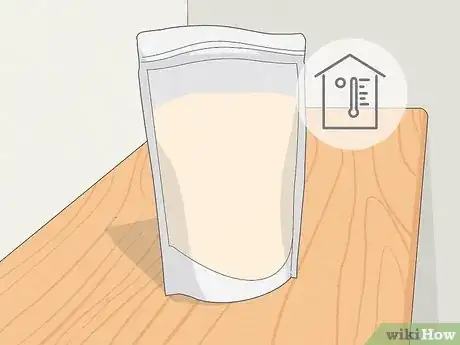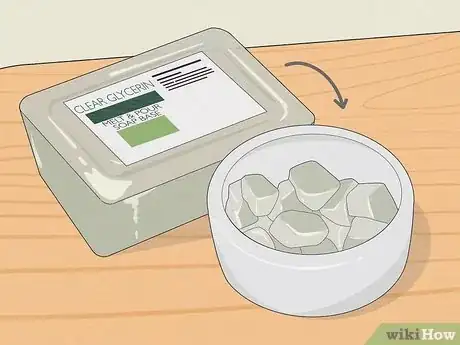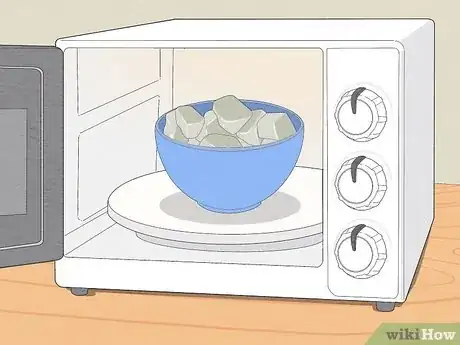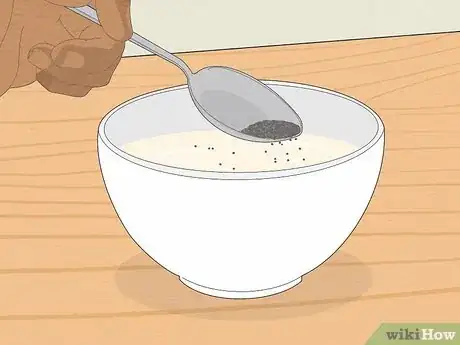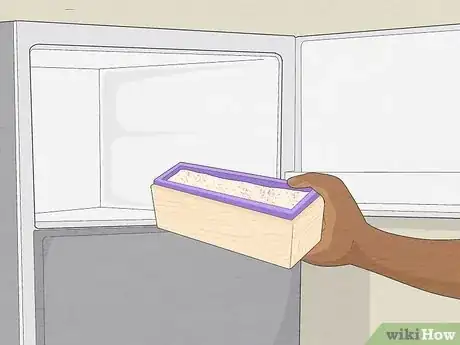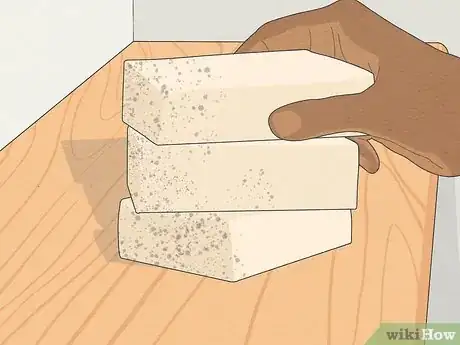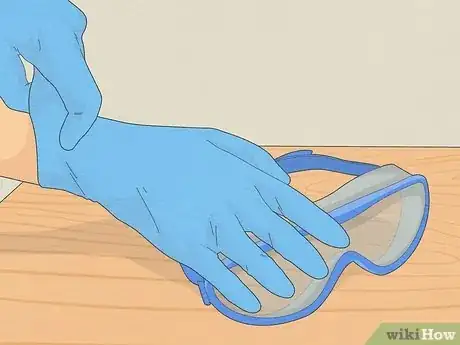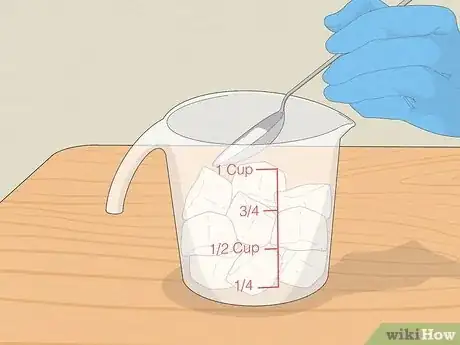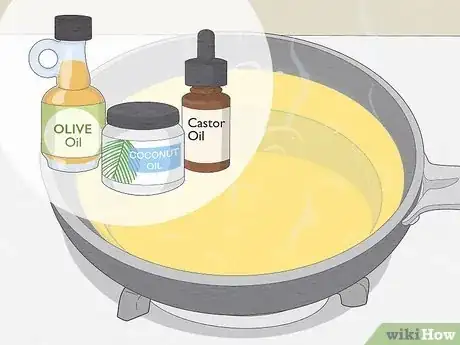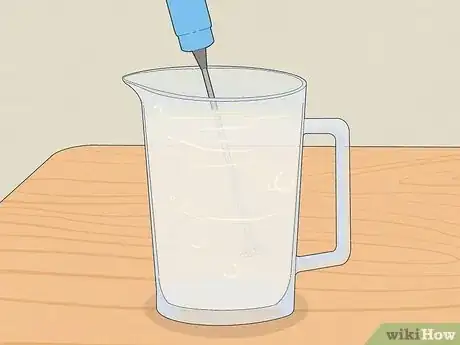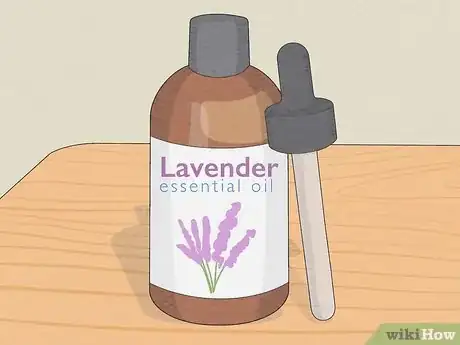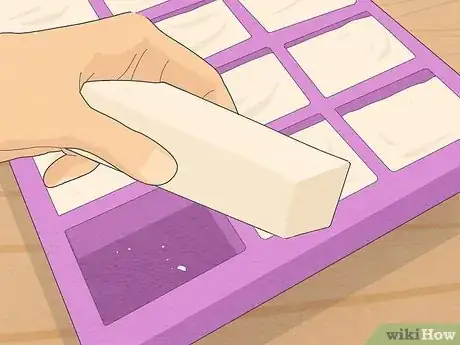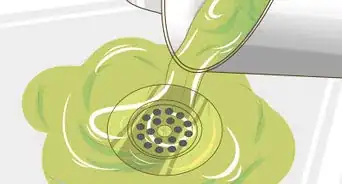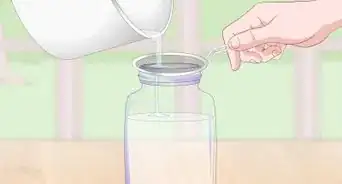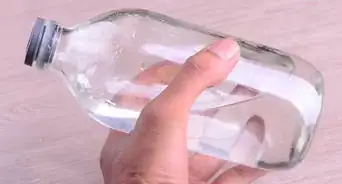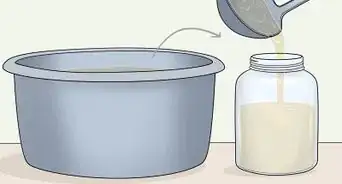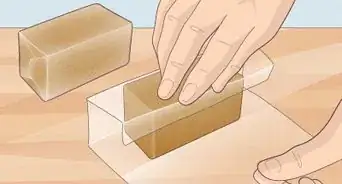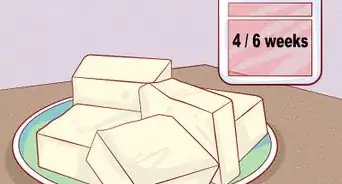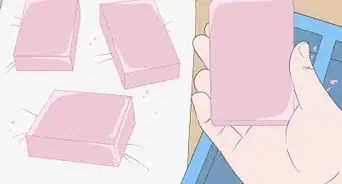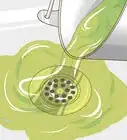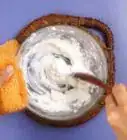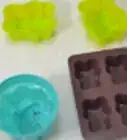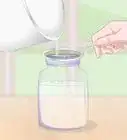This article was co-authored by wikiHow staff writer, Janice Tieperman. Janice is a professional and creative writer who has worked at wikiHow since 2019. With both a B.A. and M.A. in English from East Stroudsburg University, she has a passion for writing a wide variety of content for anyone and everyone. In her free time, you can find her working on a new crochet pattern, listening to true crime podcasts, or tackling a new creative writing project.
There are 15 references cited in this article, which can be found at the bottom of the page.
This article has been viewed 3,730 times.
Learn more...
Hoping to turn your “liquid gold” into some homemade soap? It’s definitely possible—while breast milk isn’t as potent and nourishing in soap form, its natural fattiness and sugar content give it a great creaminess and lather that adults and children alike can enjoy.[1] There are two main ways to make this specialty soap: the quick melt-and-pour method, which yields soap that only lasts a matter of weeks, and the longer cold process option, which produces long-lasting soap that’s good for 1-2 years. We’ll walk you through both methods, so you can choose the best way to use up your leftover milk.
Things You Should Know
- Melt-and-pour breast milk soap is ready within hours, but it needs to be refrigerated. Toss out your soap as soon as it starts to smell.
- Cold process soap uses lye, which makes the soap last much longer. This soap takes at least 4 weeks to cure, but it’s good to use for more than a year.
- Give your soap a special fragrance and texture by adding body-grade essential oils and exfoliants like jojoba beads and pumice sand.
Steps
Melt-and-Pour Breastmilk Soap
-
1Let the milk warm up to room temperature. Set your bags of chilled breast milk out and wait for them to warm up. The bags of milk are ready to go once they’re around room temperature.[2]
- Make sure you have 1 c (240 mL) of breast milk for each pound (453.59 g) of soap you plan on making. The average breast milk storage bag holds around a ¾ cup (180 mL) of milk, so you’ll probably need to use more than 1 bag.
- If all your milk is frozen, defrost the breast milk ahead of time.
-
2Slice 1 lb (453.59 g) of melt-and-pour soap base into small chunks. Cut up the block of premade soap into small, 1 in (2.5 cm) cubes—this makes it easier to melt down and pour into silicone molds.[3]
- Melt-and-pour soap bases are essentially large bars of cold process soap (soap that’s processed with lye). They’re made with extra glycerin, which allows you to heat the soap base into a liquid.[4]
- Melt-and-pour soap bases come in many different varieties, including shea, aloe, and honey.[5] Choose one that really meets your skin’s needs—for instance, a shea base could be a good option if you struggle with eczema.[6]
Advertisement -
3Melt the soap in the microwave for 20 seconds at a time. Transfer the soap cubes into a microwave-safe bowl and heat them up in 20-second increments. After each cycle, stir the melting soap with a spoon so it develops an even consistency. Keep heating the soap in short bursts until it’s completely liquified.[7]
- You can also use a double boiler set over medium heat to melt down the soap.
-
4Pour 1 c (240 mL) of breast milk into the melted soap base. Mix the milk into the melted soap with a rubber spatula, lightly stirring until the mixture has a smooth and even consistency.[8]
-
5Sprinkle exfoliants or essential oils into your soap mixture. Want to give your soap an exfoliating touch? Stir in 1 tsp of medium-to-large exfoliants like jojoba beads, walnut shells, coffee grounds, poppy seeds, or pumice sand. Mix the ingredient of your choice into the soap, giving the mixture a good stir until it’s between 125 and 135 °F (52 and 57 °C).[9]
- You’ll have an easier time stirring in exfoliants if you’re preparing your soap over a double boiler.
- Body-grade essential oils and fragrance oils are a great way to give your soap a refreshing scent. Just mix 0.3 fl oz (8.9 mL) of your favorite oil into your soap mixture.[10]
- Always use body-grade essential oils for your soaps, since the soap will be applied directly to the skin.
- For more exact essential oil measurements, cross-reference your ingredients with this fragrance calculator.
-
6Fill a silicone mold with the soap mixture. Drizzle the mixture into each individual well until all of the molds are filled with soap. Stick with a rectangular mold if you’d like to make traditional soap bars, or use a mold with fun shapes if you’d like to give your soap a playful touch.[11]
-
7Refrigerate the silicone mold for a few of hours so the soap sets. Melt-and-pour breast milk soap doesn’t take long to harden—after a couple of hours in the fridge, it’ll be ready to go![12]
-
8Store the soap in the refrigerator and use it before it starts to smell. Breast milk soap doesn’t come with an exact expiration date; instead, you’ll have to go by smell. Give your soap a good sniff each time you use it—if starts smelling funky, throw it out.[13]
- Melt-and-pour breast milk doesn’t go through saponification, or the chemical process that would prevent the milk in the soap from turning rancid. Because of this, melt-and-pour breast milk doesn’t last very long before the milk starts to go bad.
- Some people use melt-and-pour breast milk soap to bathe their babies.[14] However, medical experts don’t officially advise this—instead, they recommend washing your newborn baby with just regular water. Once they’re at least 4 to 6 weeks old, you can switch to an unscented baby shampoo.[15]
Cold Process Breastmilk Soap
-
1Freeze your breast milk the night before you plan on making the soap. Pour out 10.4 fl oz (310 mL) of breast milk into an ice cube tray—the smaller portions will make the milk easier to melt down with the lye. Stick the tray into the freezer ahead of time so your milk is frozen and ready to go.[16]
-
2Slip on some safety goggles, a mask, and a pair of gloves. Lye (sodium hydroxide) is an extremely harsh chemical that is dangerous to breathe in or touch. For your own protection, slide on a pair of gloves, along with some safety goggles and a mask.[17]
- Make sure that you’re wearing old clothes that you don’t mind potentially messing up.
-
3Melt the frozen milk gradually with 4.35 oz (123.32 g) of lye.[18] Transfer the frozen milk cubes into a glass measuring cup. Then, gradually stir in 4.35 oz (123.32 g) of lye, working in small spoonfuls at a time. Continue stirring in the lye powder until the milk has completely melted and liquified.[19]
-
4Heat extra virgin olive oil, coconut oil, and castor oil until they’re 90 to 100 °F (32 to 38 °C). Pour 22.3 fl oz (660 mL) of extra virgin olive oil, 8 fl oz (240 mL) of coconut oil, and 1.2 fl oz (35 mL) of castor oil together in a saucepan. Turn up the heat slowly, stirring the oils together until they’re somewhere between 90 and 100 °F (32 and 38 °C).[22]
- Olive oil is a great choice for homemade soap since it takes a long time to go rancid. Canola oil, jojoba oil, meadowfoam oil, and tamanu oil also have really long shelf lives.[23]
- This amount of oil yields about 2 lbs (907.18 g) of soap.
-
5Transfer your oils into a heat-proof pitcher and slowly add in the lye mixture. Take the oil saucepan off the stove and pour it into a large pitcher. Then, gradually pour the lye-milk mixture into the oils, using an immersion blender to combine everything together.[24]
- Power up your immersion blender in short bursts rather than running it nonstop. This prevents extra bubbles from developing in your soap mixture and keeps your blender from overheating.
-
6Add body-grade essential oils or exfoliants if desired. Pick out your favorite essential or fragrance oils, like soothing lavender or refreshing peppermint. Add 1.4 fl oz (41 mL) of body-grade essential or fragrance oil for to your 2 lb (907.18 g) batch of soap.[25]
- Check each essential oil you plan on using with this fragrance calculator if you’d like to make more exact calculations. Make sure that each oil is labeled as “body-grade” before adding it to your soap mixture.
- If you’d like to give your soap a little exfoliating power, mix in 2 small spoonfuls (around 2 tsp) of exfoliant (like jojoba beads or pumice sand). If you’d rather use a fine exfoliant (like colloidal oatmeal or bamboo powder), dilute the 2 spoonfuls with 2 US tbsp (30 mL) of distilled water or light oil before stirring them into the soap mixture.[26]
-
7Pour the soap mixture into a silicone mold and freeze it for 1-2 days. Spoon the mixture into your mold of choice—a rectangular mold is great if you’re looking to make a classic soap bar. Try to spread the soap mixture as evenly as you can across the mold. Then, slip it in the freezer for at least 24 hours.[27]
- Some DIY soap-makers prefer to freeze their molds before ladling the soap mixture in. The chilled mold prevents the soap from darkening and gives the finished product a lighter color. This is completely up to personal preference, though!
-
8Remove the soap from the mold and let it cure for at least 4 weeks.[28] Take the soap out of the freezer and remove it from the mold. Then, place the soap in a dry, well-ventilated area so it can cure completely—this allows the soap to harden even more so it has a longer shelf life in your shower.[29]
- To help with the curing process, turn on a ceiling fan or set up a small dehumidifier nearby.
-
9Use your fresh soap for 1-2 years. Cold press soap is saponified—in other words, you don’t need to worry about the breast milk in the soap going rancid. Stick your soap in the bathroom and enjoy using it for the next 1-2 years![30]
- Fragrances in your soap (from essential and fragrance oils) start to disappear after a few months, but you’re still totally fine to use it.[31]
- Don’t use lye-based breast milk soap to wash your baby, as it’ll be too harsh on their sensitive skin.[32] Instead, wash your newborn baby’s skin with plain water—when they’re at least 4 weeks old, you can start using an unscented baby shampoo instead.[33]
Warnings
- Always stir the lye into the breast milk rather than adding it to the measuring cup first. Stirring the milk into the lye could cause a dangerous explosion in your workspace.[34]⧼thumbs_response⧽
Things You’ll Need
Melt-and-Pour Breastmilk Soap
- 1 lb (453.59 g) of melt-and-pour soap base
- 1 c (240 mL) of breast milk
- Microwave-safe bowl
- Rubber spatula
- Silicone mold
- Body-grade essential oils (optional)
- Jojoba beads (optional)
- Walnut shells (optional)
- Coffee grounds (optional)
- Poppy seeds (optional)
- Pumice sand (optional)
Cold Process Breastmilk Soap
- 1.2 fl oz (35 mL) of castor oil
- 22.3 fl oz (660 mL) of extra virgin olive oil
- 8 fl oz (240 mL) of coconut oil
- 4.35 oz (123.32 g) of lye
- 10.4 fl oz (310 mL) of breast milk
- Ice cube tray
- Safety goggles
- Gloves
- Immersion blender
- Saucepan
- Heat-proof pitcher
- Silicone mold
- Body-grade essential oils (optional)
- Jojoba beads (optional)
- Pumice sand (optional)
- Colloidal oatmeal (optional)
- Bamboo powder (optional)
References
- ↑ https://rusticwise.com/breast-milk-soap-benefits/
- ↑ https://www.bellybelly.com.au/breastfeeding/how-to-make-breast-milk-soap/
- ↑ https://herahealth.co/motherhood/breast-milk-soap/
- ↑ https://www.soapqueen.com/bath-and-body-tutorials/tips-and-tricks/sunday-night-spotlight-melt-and-pour-bases/
- ↑ https://www.soapqueen.com/bath-and-body-tutorials/tips-and-tricks/sunday-night-spotlight-melt-and-pour-bases/
- ↑ https://nationaleczema.org/blog/15-tips-for-avoiding-winter-eczema-flares/
- ↑ https://mindfulnessmama.com/how-to-make-breast-milk-soap/
- ↑ https://herahealth.co/motherhood/breast-milk-soap/
- ↑ https://www.soapqueen.com/bath-and-body-tutorials/tips-and-tricks/all-about-exfoliants/
- ↑ https://www.soapqueen.com/bath-and-body-tutorials/tips-and-tricks/use-fragrance-calculator/
- ↑ https://www.bellybelly.com.au/breastfeeding/how-to-make-breast-milk-soap/
- ↑ https://www.bellybelly.com.au/breastfeeding/how-to-make-breast-milk-soap/
- ↑ https://www.bellybelly.com.au/breastfeeding/how-to-make-breast-milk-soap/
- ↑ https://www.bellybelly.com.au/breastfeeding/how-to-make-breast-milk-soap/
- ↑ https://www.nhsinform.scot/ready-steady-baby/early-parenthood/caring-for-your-new-baby/bathing-your-baby
- ↑ https://www.rebootedmom.com/how-to-make-cold-process-milk-soap/
- ↑ https://www.rebootedmom.com/how-to-make-cold-process-milk-soap/
- ↑ https://www.rebootedmom.com/how-to-make-cold-process-milk-soap/
- ↑ https://www.youtube.com/watch?v=JRwuqDm_bR0&t=1m57s
- ↑ https://www.rebootedmom.com/how-to-make-cold-process-milk-soap/
- ↑ https://www.soapqueen.com/bath-and-body-tutorials/tips-and-tricks/back-to-basics-lye-safety-guide/
- ↑ https://www.rebootedmom.com/how-to-make-cold-process-milk-soap/
- ↑ https://rusticwise.com/how-to-store-bar-soap-long-term/#types-of-oils-used
- ↑ https://www.rebootedmom.com/how-to-make-cold-process-milk-soap/
- ↑ https://www.soapqueen.com/bath-and-body-tutorials/tips-and-tricks/use-fragrance-calculator/
- ↑ https://www.soapqueen.com/bath-and-body-tutorials/tips-and-tricks/all-about-exfoliants/
- ↑ https://www.rebootedmom.com/how-to-make-cold-process-milk-soap/
- ↑ https://www.rebootedmom.com/how-to-make-cold-process-milk-soap/
- ↑ https://soapstartup.com/how-long-does-handmade-soap-last/
- ↑ https://soapstartup.com/how-long-does-handmade-soap-last/
- ↑ https://rusticwise.com/how-to-store-bar-soap-long-term/#is-it-okay-to-use-expired-bar-soap
- ↑ https://www.bellybelly.com.au/breastfeeding/how-to-make-breast-milk-soap/
- ↑ https://www.nhsinform.scot/ready-steady-baby/early-parenthood/caring-for-your-new-baby/bathing-your-baby
- ↑ https://www.soapqueen.com/bath-and-body-tutorials/tips-and-tricks/back-to-basics-lye-safety-guide/
